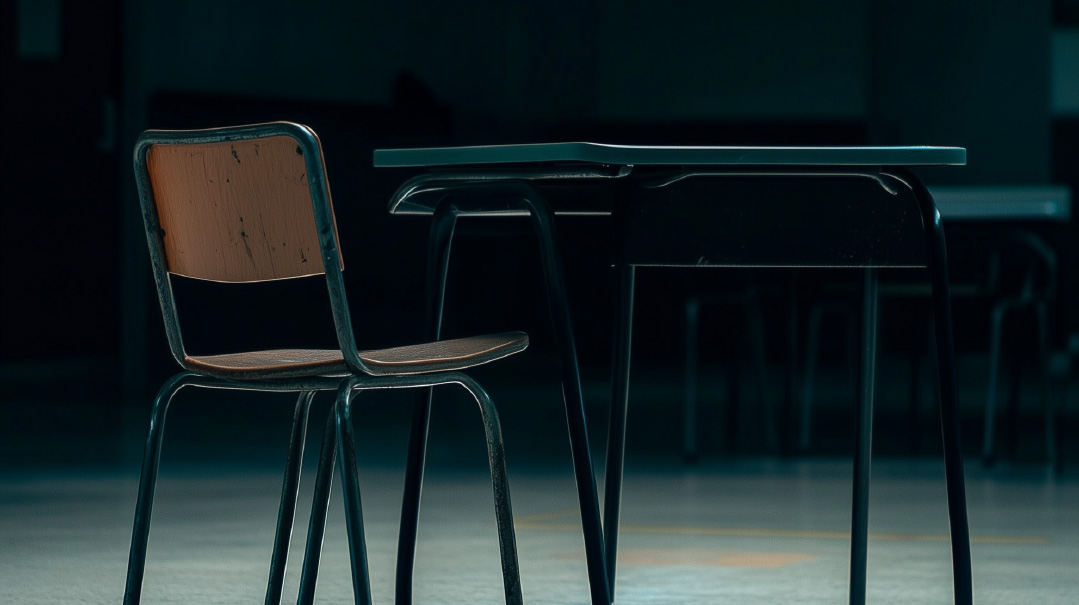Attendance Deficit
| August 27, 2024What causes kids to refuse to go to school and what can we do about it?

The alarm clock rings again, he rolls over and goes back to sleep, missing yet another day of school. She’s up and ready to go, but when it’s time to leave the house, she freezes. He’s fine until he gets to the school gates…Chronic absenteeism is a crisis across America, but what happens when the crisis involves your kid, hits your home? What causes kids to refuse to go to school and what can we do about it?
It’s 8:49 a.m., and Batsheva was already on edge. Tension pulsated through her veins, and she breathed to steady herself.
Waking up her household with a gentle knock and cheerful “Good morning” worked for most of her children. Of course, they didn’t relish leaving their cozy beds and heading to school, but after the requisite morning mumbles and grumbles, they began their morning routine.
Except for Shua.
The battle to get him to go to school was an endless one. He often slept straight through his alarms, lying in bed for hours and hours, and missed school. Which is why she made a feeble attempt to wake him every morning.
She paused before knocking and entering Shua’s room. In the eye of the hurricane he called a bedroom, he slept peacefully. She was loath to disturb him.
As she nudged him gently, she wondered, Maybe today will be the day. Maybe today he’ll get up and go to school and do the things “normal” kids do….
When other parents complained to Batsheva about their kids being sick and out of school, she would think: You think that’s hard? You know your kid is going back tomorrow. Or next week. My kid hardly leaves my tiny house.
There was also the safety issue. Shua would literally sleep through the smoke detector. So while Batsheva was technically able to leave him home alone — he was old enough at 14 — he wasn’t safe while he was sleeping. When she left for work, she fretted about his safety.
Some mornings, she gave him a window of time to get ready, saying, “I’ll be happy to drive you if you’re ready in x minutes.” And then he would get up and move really slowly. Slowly to the bathroom. Slowly to put his clothes on. Slowly to prepare food for his school day.
And all the while she kept trying to just breathe, breathe, breathe.
An Emotional Problem
The most recent US federal data show that in the 2020–21 school year, at least 14.7 million students nationwide were chronically absent, meaning they missed ten percent or more of school days, about 18 days, in an academic year. Missing school on such a regular basis is detrimental for a kid’s development. A 2013 analysis by the nonprofit Attendance Works, based on data from the National Assessment of Educational Progress (NAEP), found that students who miss more school than their peers consistently score lower on standardized tests.
Devora Schuck LCSW, a therapist who has worked with many parents dealing with school absenteeism, says that when a child presents with this problem, the first thing parents should do is rule out possible physiological explanations. Is there a medical reason for their ongoing absences? Is the child low in essential vitamins or minerals, affecting their functioning? Is he perhaps suffering from PANDAS?
Once that has been ruled out, Devora emphasizes the importance of looking at a child’s history, what was going on around the time the school avoidance began — or right before — to get insight into the root of the maladaptive behavior. In some cases, an undiagnosed learning disability presents itself, one that the child couldn’t compensate for anymore. In others, anxiety, trauma, or bullying can be the culprits, resulting in school becoming an unsafe space for the child.
This was the case with Shua. As far back as Batsheva could remember, Shua struggled socially. He was constantly frustrating everyone around him. He hurt. And of course, as his mother, Batsheva hurt, too.
As his teenage world became increasingly complicated, Shua eventually shut down completely. It was easier to sleep than navigate life’s social labyrinths. School became a place of traumatic association. He would keep himself busy during class to distract himself. Eventually, he just stopped caring and stopped going to school.
This was also the case for Rivky’s daughter Dassy. She was four when she began refusing to attend school. She’d get up, get dressed, eat breakfast, and pack her schoolbag — but then refuse to leave the house. “It was heartbreaking to watch. It was like the front door became a solid wall for Dassy, and she couldn’t move herself through it,” says Rivky.
“My daughter is anxious in general. Dassy kept telling me, ‘My teacher is mean.’ She would refuse to go into school. If I got her as far as the school building, she would just stand outside in the classroom doorway, refusing to enter.”
Rivky explains that while she doesn’t believe the teacher was necessarily mean, she definitely had a style her daughter wasn’t used to. The teacher was rigid and strict, and Dassy felt intimidated and shut down.
The bottom line is, says school psychologist and education consultant Zipora Schuck, MA MS, “School avoidance almost always stems from an emotional place, not behavioral. Parents need to understand this. Schools need to understand this.” Or as Dr. Jonathan Dalton of the Center for Anxiety and Behavioral Change in Rockville, MD put it, “Avoidance is the lifeblood of anxiety, so school refusal is the ultimate example of avoidant coping.”
An Emotional Solution
Since the root of school avoidance is emotional and stems from a lack of feeling safe, the healing approach must also be emotional — and not behavioral. As Sarah Kaplinsky, a school counselor in a Midwestern day school says, “Schools often think that school avoidance is a behavioral problem. A smart mental health professional needs to help dig, to determine the emotional reason behind the avoidance. Kids don’t do things for no reason. What child wants to be different from their peers? There’s usually something underneath the behavior, something distressing to the child that’s causing them to behave in this way.”
Principals will often say things to school avoiders like: “Well, if she didn’t come for XYZ, she can’t come for the major performance,” or threaten middle/high school students about grades.
This is unacceptable, Zipora maintains. The last thing a child needs is a threat or a punishment. And for practical purposes, it rarely works. The child is suffering, and they’re ashamed of their behavior. They’re trying to survive in any way they know, and avoiding school is what’s in their power right now. Grades are the last thing on their list of importance.
“Schools need to recognize that the child is not being manipulative or taking them for a ride,” explains Devora. “When a child says, ‘I’m not going to school because it’s so stupid,’ that won’t necessarily tell you there’s been a trauma. It can take time to uncover the cause.”
Unwitting Reinforcement
Malky, a principal of a large girls’ elementary school in the Tristate area, has definitely encountered this struggle with students. She agrees that school avoidance usually starts out as an emotional issue, but it can very quickly morph into a behavioral issue if parents aren’t mindful of the potential pattern.
Let’s say a child had a hard day in school — she was embarrassed by someone, a teacher made a mistake, she failed a test. The child doesn’t want to go to school the next day in order to avoid similar discomfort. The parents allow the child to stay home, figuring it’s a needed short-term “break” — and sometimes that is all the kid needs to regain her equilibrium.
But sometimes the child stays home, and then stays home again. With each passing day, the pattern of avoidance gets reinforced — and the child becomes more and more afraid of school.
Parents should be careful: Don’t let school avoidance become a behavioral thing, if you can help it. The solution to this, says Malky, is that as soon as you see something happening, try to nip it in the bud. Be curious, ask questions in a safe and supportive manner. The earlier this gets clarified and stopped in its tracks, the better.
Malky says that sometimes, parents naively contribute to the problem. She recalls a student who was refusing to attend school, and as they dug deeper, they discovered the child was receiving candies and prizes when she was home from school!
There Is Hope
Sometimes Batsheva would use good parenting techniques when dealing with Shua’s school refusal. But other times, she’d wheedle, cajole, beg, bribe… and then succumb to threatening and yelling.
And then — the yelling would work. Shua would get up for school, and Batsheva would feel sick. Her stomach hurt. Her back hurt. She knew her erratic methods weren’t helping the situation. But then he expected Batsheva to bring him to school. Right then. Regardless of what she was doing. “It’s so hard for me to get up, and I did it. I need to go now! Didn’t I just do what you wanted?” he’d say.
But Batsheva’s mornings were so precious to her. She had calls to make for work. And when Shua sauntered in suddenly, she felt frustrated. Her personal space was invaded.
She wanted to scream. A bloodcurdling, frustrated, visceral scream that would release all her tension, anger, and overwhelm. Would this ever get better? Could it get better? And why did she feel so alone?
What Batsheva didn’t realize was that by collaborating with a mental health professional and the school, she could begin the process of getting out of this mess.
Safe and Supported
Determining the reason school feels so difficult for the child is the first step to creating a successful plan to get a child back to school. The School Refusal Assessment Scale (SRAS-R), a psychological assessment tool created by psychiatrists Dr. Chris Kearney and Dr. Wendy K. Silverman to assess what is causing a child’s school refusal, is often used to best inform the proper interventions.
Interventions will look different for every child. For some children, even getting out of bed can be a challenge. For others, getting out the door to school is hard — but once they arrive, they’re mostly okay. For some kids, even entering the building is intimidating. These children may need practice getting themselves into the building, even multiple times. A child may benefit from driving by the school when it’s empty or going into the school when it’s empty. Some children can go into school but need to spend less than a full day at school to reacclimate. A plan for getting them to and from school also needs to be worked out as part of this.
The goal of any intervention must be to help a child feel safe and supported as he slowly pushes out of his comfort zone.
“Any school-avoiding child faces a new struggle with each new week, so getting the week off to a good start is very important. Starting to implement the plan on a Monday can make a big difference. It’s much harder to start on a Tuesday,” points out Devora.
At times, medication is a necessary part of the plan. Even a really small amount of antianxiety medication, Zipora maintains, can be the difference between a child suffering for a short time or a really long time. A small dosage, for even a short amount of time (obviously under the guidance of a medical professional) can be pivotal in breaking through the anxiety so a child can get back on track.
“I did an ‘exposure-type’ plan with her,” says Rivky about her daughter Dassy. ‘I initially accompanied her to school and we stayed there together for a small amount of time. Gradually, I slowly increased her classroom time and weaned her off of my presence. My husband and I also made a social story with her about school being a positive experience. Finally, the combination of all my efforts paid off, and Dassy reintegrated into the classroom.”
A safe place or safe person in school is vital for a child to ride out the discomfort of school reentry, suggests Zipora. When feelings of anxiety become overwhelming, the child can go to their safe person or safe place. Ideally, the safe place could have a “calm-down” box that contains items to help the child release negative or intense energy. For older kids, a “9-1-1 card” could be helpful, with a list of clearly delineated steps that he/she could take when they feel panicky at school, such as remember to breathe, go to the nurse, take a sucking candy. A transitional object such as a locket with a picture of a safe person can be calming as well.
Incentives are helpful to keep the child’s motivation up, Devora says. It’s important to remember that we aren’t rewarding the child with drones or trips for something every child should be doing anyway, i.e., going to school. Rather, we’re offering incentives to help support a very challenging process for this specific child.
And success breeds success. Everyone involved needs to celebrate the process, every tiny step of improvement. Building a new habit is establishing new wiring in the brain. It takes time, consistency, and a boatload of patience.
On Her Own
Batsheva’s son Shua would miss days and days of school without anyone from the school checking in. Once, when Batsheva pressed the rebbeim to call, hoping Shua would be motivated if his absence was noticed, a rebbi finally called. “Hi, this is Shua’s rebbi. Can I speak to him and tell him how much we miss him, even though all he does during my class is Sudoku?”
Batsheva thought the pain would kill her.
A different time, she desperately asked the rebbi to drop off pizza or take Shua out — and that she’d pay for it, behind the scenes. But to no avail. The response was: “If we do that, will that get Shua to come back to school?”
Batsheva continued to beg the school for help, but they just pinned her as the incompetent mother who “doesn’t know how to take care of her kid.” She tried arranging for Shua to get help through the school social work program. He had someone amazing working with him for a while, but then the school cut off the support cold turkey, and wouldn’t explain why. All the pleading Batsheva did got her nowhere, and Shua was devastated. They kept telling her, “He’s not available anymore. Shua needs his own therapist outside of school.”
Batsheva was on her own.
Getting the School Involved
A key factor in returning a child to consistent school attendance is unified support from parents, school staff, and a mental health professional. This takes a tremendous amount of love and attention on the teachers’ part.
Rivky felt that Dassy’s school was well aware, patient, and understanding, but that practically, they didn’t give her a lot of support, because when Dassy did show up, she was a well-behaved child, so the school viewed the school refusal as a parent issue, not a school issue. “When she was in school, she was the sweetest ‘defiant’ child they had ever met,” says Rivky.
Rivky wishes she’d had a school point person to touch base with during a difficult morning. Someone who’d call and say, “Hey Dassy, where are you? We miss you.” Rivky feels that if Dassy would know she was wanted and missed at school, that knowledge alone could help her move past the challenge of the moment, the challenge of walking out that front door.
At the same time, Rivky recognizes how much teachers have on their plate. “If the teacher has [a break and then] a choice to go to the bathroom, or get a cup of coffee, or call my child, I think the teacher needs to take care of herself at that moment. I completely understand why the teacher is not doing that for my child. The one day I did speak up to a teacher, she called within the hour, spoke to Dassy, and asked her what was going on.”
A nice idea for teachers to make all kids feel seen is to dedicate a little corner of the board to a section called “today we missed so-and-so,” suggests Devora. It can also serve as a visual reminder for the teacher of whom to welcome back each day.
Then, for children with an absentee issue who would appreciate the recognition, teachers should show their excitement and happiness in seeing the child. For children who shy away from attention, it’s helpful to not make a big deal when the child comes, just to smile and let the kid be comfortable. In a subtle way, they can show the child how happy they are that they are in their classroom.
If the school isn’t on board, says Devora, parents can find a professional to serve as a liaison between the parents and school. An outside person — even a rav or pediatrician — can encourage the school to work along with parents to try to find solutions to this problem.
Open Endings
In the end, a school point person was Shua’s saving grace. One rebbi who really believed in him would call whenever Shua didn’t show up to his classes. Shua must have sensed his rebbi’s trust in him, because his school attendance started improving that school year.
Even when things seem to be heading in the right direction and the child is back to regular school attendance, things can fall apart again. Improvement with school avoidance is not a linear process. Even when taken care of at an earlier age, it’s not atypical for kids to start up with this again at a later stage.
“We’re not saying this to be discouraging, rather, for parents to be realistic. This is a big issue. It takes time, patience, and a huge dose of understanding from all the adults in a child’s life to support a child through this struggle,” says Zipora.
That was Shua’s story. That year with the rebbi that believed in him saw an improved attendance record, but in the subsequent school years, it was on and off, very much dependent on his relationship with his current teacher.
Which just showed Batsheva that the most important thing in preventing a relapse is for a child to feel valued, have their absence noted, and receive strong school support during the reentry process.
Suggestions for parents:
Do:
Recognize that this process takes time.
Understand that this isn’t about something YOU did wrong.
Get support for yourself so you can be patient and calm with your child.
Don’t:
Show your child how irritating and inconvenient this issue is.
Don’t let your kid have a one-off day off from school as a method of coping with an unpleasant event, as it can morph into a pattern.
Suggestions for schools:
Do:
Recognize that the school avoidance is emotional, not behavioral.
Work collaboratively with parents and professionals.
Set up a school point person to check in with the family when the child doesn’t show up.
Don’t:
Ignore the child! (This was the most prevalent theme with every parent we spoke to.)
Penalize or institute consequences (they won’t work anyway).
Jump to blame parents.
Parents interested in joining a support group for this challenge can contact the writer through Mishpacha.
(Originally featured in Family First, Issue 908)
Oops! We could not locate your form.







